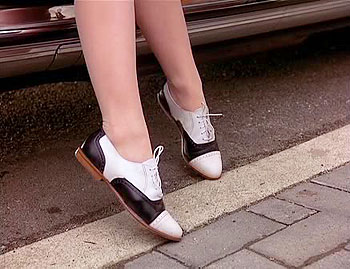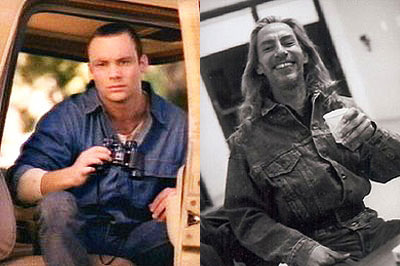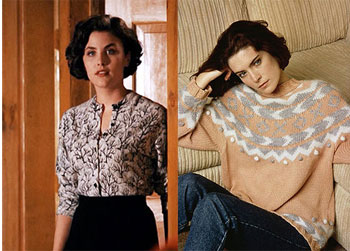Saddle Shoes and Winnipeg Tuxedos: Fashion In Twin Peaks
Published on July 30th, 2011 in: Issues, My Dream Is On The Screen, TV, We Miss The Nineties |
Watching Twin Peaks from a remove of over twenty years conjures a rush of emotions: The tragedy of an innocent’s brutal murder, the suspense of unraveling the mystery, the fear of the uncanny, and the occasional revulsion at the wardrobe. Holy angora, viewers may think. Did people actually dress like that in the early ’90s?

For those of you who haven’t seen the series since its initial broadcast and have blocked out everything short of Sherilyn Fenn, you may have forgotten the endless parade of mom jeans, lumberjack flannel, knockoff Cowhican sweaters, army boots, floor-length plaid skirts with slits up to here, crispy perms, and Winnipeg tuxedos. The swaths of polyester, miles of brown lipstick, and wide array of mullets might at first seem contrary to the aesthetic of a director whose cool sense of style has launched a million Vogue photo spreads. Twin Peaks co-creator David Lynch is so well-known for his tweaking of bourgeois values and aesthetics that no less an authority than Roger Ebert has mocked him for it: ” . . . beneath the surface of Small Town, USA, passions run dark and dangerous? Don’t stop the presses.”

Lynch, costume designer Sara Markowitz, and the hair and makeup crew grounded our perceptions of “Small Town USA” innocence through the wardrobe and general appearance of fallen angel Laura Palmer. In her only appearance alive on camera, her wardrobe looks like a grunge-era variation on a school uniform, with a pleated tartan skirt and twinset. The earthy tones of her turtleneck and cardigan contrast dramatically with her porcelain skin and blonde hair, giving her an even more angelic appearance. Laura’s best friend Donna Hayward has a similarly frumpy appearance. Her skirt hems brush the floor, and she wears bulky sweaters with Fair Isle motifs and bobbles. Like David Lynch himself, Donna always buttons her blouses to the sternum. The yellowy earth tones and light pastels in which she is garbed wash out her pale complexion, and her short, permed bob makes her pinched face look severe. Her clothes—particularly her sweaters—seem to hang off of her, and the sum total of her high collars and maxi-skirts at times suggest a nun or a cancer patient more than a schoolgirl.

Audrey Horne contrasts dramatically with the innocent appearance of Laura and Donna. Audrey, the poor little rich girl of Twin Peaks, is perceived to be more sexually experienced and worldly than her purer-seeming peers. Her introductory scene sets up many of these themes: She exits her family’s large pile of a house to go to school, clad in a snug sweater the pink of a pinup girl’s dreams, and in a plaid skirt at least a foot shorter than the ones Donna wears. As she gets into a chauffeured car bound for Twin Peaks High School, the camera lingers on her saddle shoes, which she later trades in for a pair of red pumps. Later episodes would feature Audrey dressed in clingy red angora sweaters, cardigans screen printed with ghostly tree branches (coveted in vintage stores as “Darlene’s Nightmare”), lacy blouses, and pencil skirts. The character’s confidence and sense of mischief combined with Sherilyn Fenn’s ripe sensuality helped to make Audrey the fashion icon of Twin Peaks.
We soon learn that Laura’s image as an icon of purity is at odds with her afterschool exploits. Likewise, in the middle of Season Two Audrey reveals that she is a virgin. Not long after this revelation, Audrey starts to right her image by playing a greater role in her father’s business. Her wardrobe reflects this sea change in her perception. She trades in her saddle shoes, plaid skirts, and pinup girl sweaters for sensible pumps, turtleneck sweaters, and business suits. While this shift in her appearance suggests that she wants to be taken seriously as a young businesswoman and an activist, her focus on covering up her figure and donning double-breasted suits make her look like the prow of a boat.

Some of Audrey’s suits have a 1940s vintage flair. They make a nice complement to the spiffy suits worn by Special Agent Dale Cooper, the object of Audrey’s unrequited love. Compared to the khaki-clad, be-mulleted crew with whom he works, Cooper cuts a suave figure in his black suits, shiny shoes, and dapper trenchcoat. On its own, his elegant style (which another character compares to Cary Grant) suggests a sense of professionalism one might associate with detectives in films noir. His manner of dress contrasts with the khaki-clad members of the Twin Peaks police. We can see from the way he presents himself that his manner of investigation will be a little different from those in which the department has previously engaged.
While Lynch and Markowitz’s school uniform-like costumes reinforced our initial perception of Laura Palmer as fallen innocent, they play into cultural stereotypes in other characters. The brutal Leo Johnson looks like the textbook illustration of a man who beats his wife, sells drugs, and engages in white slavery. Before he so much as grunts at his adorable wife Shelly, we suspect him of Laura Palmer’s murder on the basis of his long, stringy hair and his fondness for the denim-on-acid-washed-denim look. Likewise, Killer BOB’s appearance was the stuff of nightmares on the show’s original broadcast. Watching it 21 years later, one can’t help but wonder if this is due to his head of volumized hair and his similar fondness for the fashion don’t known as the Winnipeg Tuxedo.

Other male characters on the show seem to precipitate the trends that would define the coming decade, for example, Laura’s high school boyfriend Bobby Briggs. Like Laura, Bobby occupies a dual role in the series; he’s both the star of the football team and a drug runner who supplies to his girlfriend. Bobby’s costume of worn dungarees, flannel shirts, and work boots was not only representative of what every teenage boy in the Pacific Northwest was wearing at that time, but what every first-world teenage boy would wear for the next ten years. While Marc Jacobs and Kurt Cobain are credited with starting the grunge boom, Bobby’s similarly flannel-happy appearance is an unsung influence on the ensuing trend in supercasual, “edgy” menswear.
You don’t need the Log Lady to tell you that Twin Peaks was a massive hit straight out of the gate. The stylized, vintage-influenced clothing influenced many of the trends in the coming year—even Sassy magazine ran a Peaks-inspired photo spread with information on how to buy vegan saddle shoes and mizpah necklaces. Dean of American fashion Calvin Klein and indie designer Therese Rawsthorne have recently graced the runways with maxi-skirts and clingy sweaters redolent of those worn at Twin Peaks High School and alternative magazines like Bust, Vice, and Worn have devoted several pages in recent issues to Peaks-inspired editorials. In spite of its short life on broadcast TV, Twin Peaks has had a long afterlife as inspiration for fashionistas everywhere.
Time limit is exhausted. Please reload the CAPTCHA.